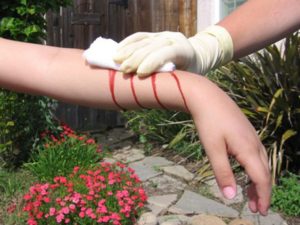Basic first aid – All about first aid for heart attack, for burns, for fractures, for electric shock, snake bite and for dog bite. First aid is basically emergency care. It is not medical treatment and you should not compare what you can do with what a doctor can do.
All about basic first aid for all situations !
Nobody is expected to make medical decisions, but only simple common sense decisions that seem to be in the best interest of the injured person.
First aid involves
Checking for breathing, choking, bleeding and consciousness. Doing this can save a precious life, while awaiting for professional help. Get the injured and yourself away from hazards as soon as possible. Do not get trapped by collapsing buildings, gas, smoke or fire.
Get help as soon as possible. Do call for professional help, since they have the equipment and knowledge and are used to taking the responsibility when things go wrong. Tell the professionals over the phone, as to how many casualties there are, what exactly happened, your phone number and whether any special equipment is needed.
Reassure the injured person and keep him as happy as possible. Basic first aid can be administered to patients by everyone. All must also be aware of first aid for snake bite, burns, fractures, heart attack and first aid for electric shock.
If there are many casualties, decide quickly which one needs urgent attention and if necessary quickly show a bystander, how to do artificial respiration or heart massage.
Don’t worry yourself into doing nothing for fear of doing the wrong thing. You are, after all, not expected to know about all the conceivable complications that might arise from your actions.
Once you have carried out life-saving procedures, do nothing, unless you are absolutely sure of what you are doing.
Take charge and organize. Ask others to help in other ways, while you do the first-aid. Of course, should there be a doctor or a nurse in the crowd, they can take charge of the situation. It is important to have a first aid kit or box to be able to give the basic aid for all types of emergencies.
Always stop when you see an accident, unless professionals are already at the scene. Lastly, knowing what to do puts you in a privileged position but it also carries responsibilities.
Important notes about basic first aid
There are many situations which may require first aid, and many countries have legislation, regulation, or guidance which specifies a minimum level of first aid provision in certain circumstances. This can include specific training or equipment to be available in the workplace (such as an automated external defibrillator), the provision of specialist first aid cover at public gatherings, or mandatory first aid training within schools.
First aid, however, does not necessarily require any particular equipment or prior knowledge, and can involve improvisation with materials available at the time, often by untrained persons.
First aid training
Training is generally provided by attending a course, typically leading to certification. Due to regular changes in procedures and protocols, based on updated clinical knowledge, and to maintain skill, attendance at regular refresher courses or re-certification is often necessary.
First aid training is often available through community organizations such as the Red Cross and St. John Ambulance, or through commercial providers, who will train people for a fee. This commercial training is most common for training of employees to perform first aid in their workplace.
Many community organizations also provide a commercial service, which complements their community programmes.
Also basic aid is generally performed by the layperson, with many people trained in providing basic levels of first aid, and others willing to do so from acquired knowledge. Mental health first aid is an extension of the concept of first aid to cover mental health.
RELATED TOPICS
Personal trainer certification
Personal injury lawyers in Phoenix
Online medical assistant schools

